When the European Space Agency (ESA) Rosetta spacecraft set down on comet 67P/Churyumov-Gerasimenko on September 30th 2016, it marked the official completion of a 12-year mission covering almost 8 billion kilometres. Whilst analysis of the data returned by Rosetta and its diminutive lander Philae will continue for decades, the journey is at an end for two beloved social media personalities spawned by the mission, for as tough as chasing down a comet may be, the Rosetta team had another objective that seemed almost as elusive – how to re-engage the interest of the general public following Rosetta’s lengthy hibernation and communicate the mission’s key goals and context.
Although not entirely without precedent, the approach ESA chose and its subsequent implementation have proved hugely successful and given the mission something no amount of clean-room engineering can bestow – heart. As the mission drew to a close, the world had fallen for the two plucky explorers, for we were no longer thinking in terms distant boxes of circuit boards and solar arrays – Rosetta and Philae had become our emissaries, seeing, touching and tasting what we couldn’t and doing it all with a sense of wonder and smiles on their faces.
Once upon a time…
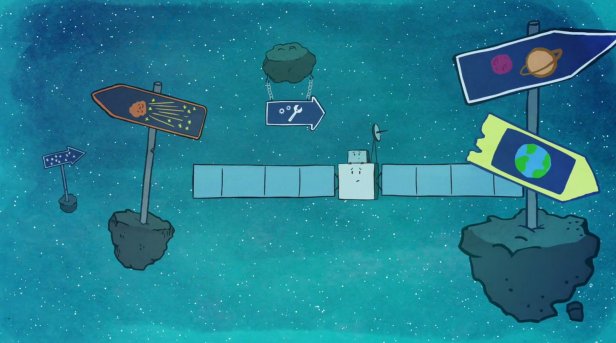
The decision to create a cartoon series around the mission as part of a wider strategy originated in 2013 as ESA’s communications team geared up for a series of social media activities to raise awareness around Rosetta’s big wake-up. Dr Emily Baldwin, Space Science Editor for ESA Portal explains “We wanted to think of different ways to engage the public in the lead up to the wake-up from hibernation, because we didn’t want people to miss out on the once-in-a-lifetime opportunity to witness a mission that would be the first to rendezvous with a comet and deploy a lander to its surface later in 2014”. Four short films were commissioned and one of these was to be a story-book style animation, Once upon a time… explaining the mission so far and the challenges to come.
With a basic narrative in place ESA began working with communications agency Design & Data GmbH (D&D). Initial styles for the animation were proposed with particular attention paid to the presentation of the spacecraft themselves. The challenges of distilling an extremely technical mission into a form that would appeal to a global all-ages audience were far from simple. The Japanese Space Agency (JAXA) had pioneered the use of ‘kawaii’ illustrations of spacecraft and D&D now worked in a similar direction to create engaging visual representations of Rosetta & Philae.
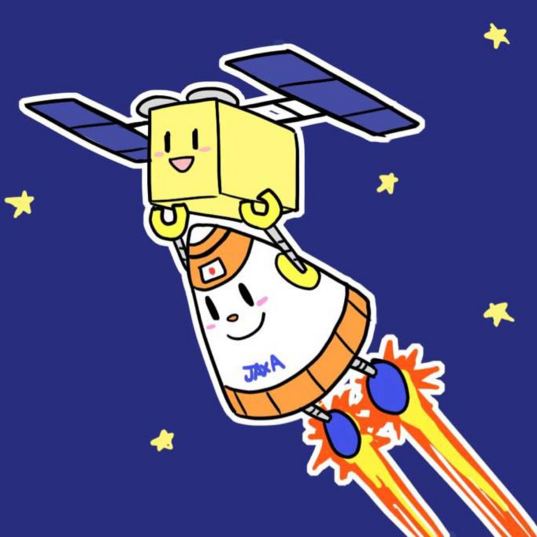
The tone of the cartoons was markedly upbeat, but never avoided communicating concern and apprehension on behalf of the spacecraft for the challenges ahead, reflecting the very real sense of uncertainty about what was to come felt by scientists and engineers on the ground. Dr Claudia Mignone, science writer for ESA adds “The cartoon storylines are scripted by our team of science communicators here at ESTEC – we have closely followed and communicated the development of the mission over the past few years so have the knowledge and background needed to create an accurate portrayal – and drawn and produced by our collaborators at Design&Data, with many iterations between us to make sure that the information content is correct while the narrative and style remain engaging.”
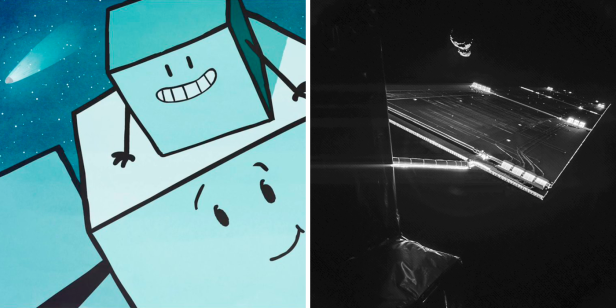
This ‘family’ analogy was further strengthened by the inclusion of ESA’s historic Giotto probe (which had its own comet rendezvous with Comet Halley in 1986) as a grandfather guiding his two young relations through a brief history of cometary exploration. Other comet probes were also introduced as cousins, helping to communicate the Rosetta mission’s place in the wider span of exploration. As they travelled toward their destination we saw Philae and Rosetta learn how comets have been perceived and portrayed throughout history, giving context to the role their own observations would play in our growing understanding of our cosmic origins.
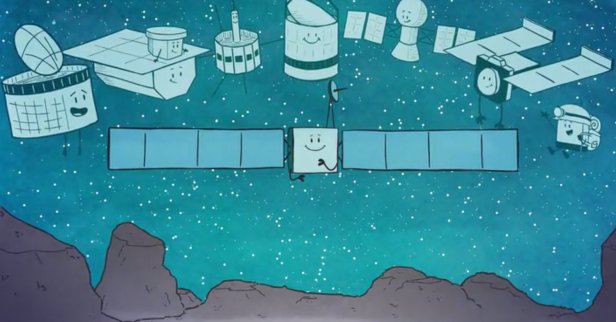
Into the dark
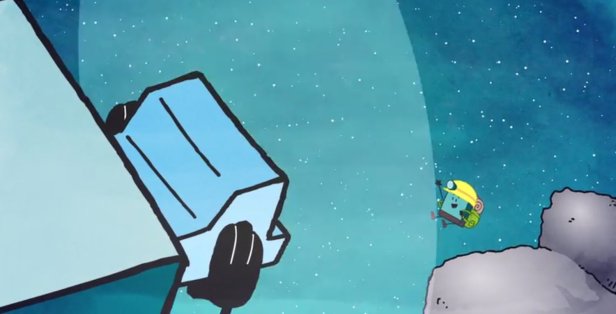
As the actual probe touched down the thruster and harpoons designed to push it down and anchor it to the comet’s surface failed to work, leading to a tense few hours for those involved in the mission as Philae bounced and drifted above the surface before coming to rest in a dark area. Although the probe’s instruments were able to operate, it quickly became apparent that this location meant there would be insufficient sunlight to charge the secondary batteries Philae would need for longer duration studies. After three days, the lander went into hibernation mode and contact was lost. As a response to the huge public interest in the landing, D&D were quickly able to produce an illustration of Philae on the comet’s surface with his miner’s helmet and an ESA flag, which was released the day after the landing. Later episodes showed Philae hard at work on the comet before settling down in a sleeping bag for a long dream-filled sleep.

But while Rosetta’s independent science mission continued, the mission team never gave up on attempts to find Philae. The lander was briefly able to reach out and communicate on June 13th 2015 and a grainy cartoon image of Philae’s calling his sibling was released, becoming popular across social and news media, but the lack of an accurate location for the lander’s resting place made it difficult to give full context to some of the surface science results and images.
The efforts of the imaging team finally paid off as Rosetta’s mission neared an end in September 2016. After a series of very near misses and false targets, an unmistakable image of the lander lying in a shaded area was finally captured. This achievement seemed a perfect summation of the mission and #PhilaeFound was soon trending on Twitter along with cartoon images and relieved first-person tweets between the siblings on ESA’s curated social media accounts.
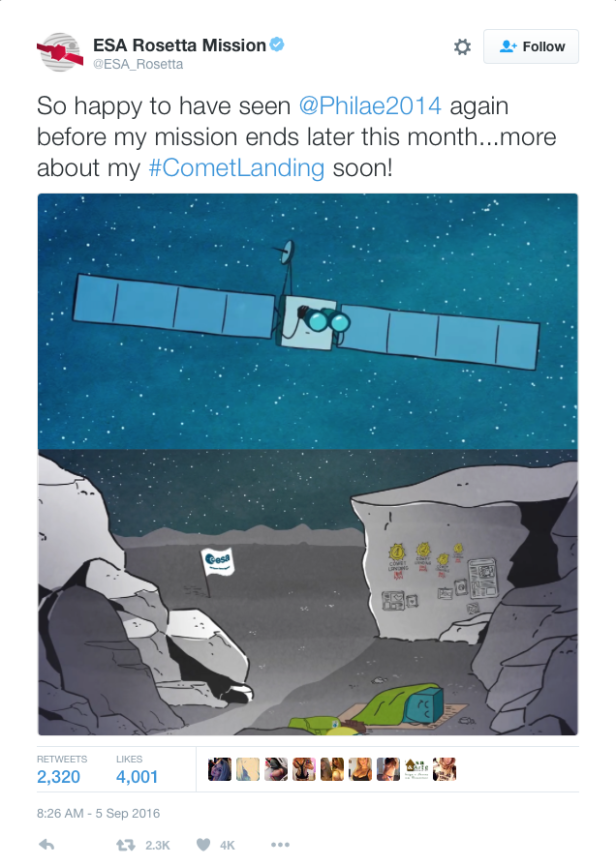
“It was particularly hard deciding how to end the cartoon series given how much people – including us! – had grown to love the characters over the last 2-3 years.” comments Baldwin “In the end, with the real Rosetta ending its mission on the comet, this presented a very natural storyline of Rosetta and Philae being together again… and [spoiler alert!] who knows if they will be discovered by travellers in the future…?”
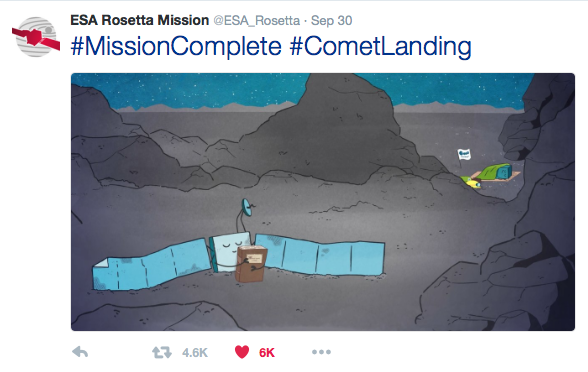
According to Mignone, “We’ve spotted a number of scientists promoting the cartoons on their social media channels and adopting the anthropomorphised spacecraft as their avatars, even sporting the cartoon t-shirts and hoodies at conferences” and with regards to the reaction of the mission scientists to seeing their work portrayed in simplified form by the cartoons, she adds that the communication team have received compliments from their colleagues “on both the accuracy and entertaining portrayal of their particular science result – it certainly seems appreciated that we fit a lot of accurate science content in!”.
Plush Rosetta and Philae toys have become a best selling item in ESA’s commercial outlets, downloadable paper models of the spacecraft have been a popular item, and follow-up Tumblr accounts now allow the public to share their own interpretations of the two space bound heroes and what the 12 year cosmic odyssey meant to them.

So it certainly appears that the communications campaign around the Rosetta mission has been a huge success for ESA “The vast majority of the comments we received on our public platforms, independent channels and via private messages were positive and appreciative.” comments Baldwin “After the first episode, members of the public were happily surprised that ESA had engaged in such a fresh style of communication. Later, as the story built up episode after episode, the audience appreciated the accuracy with which the operational and scientific aspects of the mission were portrayed in the story, which allowed them to follow along in an appealing and at the same time accessible way.”

Effective communications strategies are vital to any large-scale publicly funded space project – this can be a case of “No bucks, no Buck Rogers” as Tom Wolfe so memorably put it in The Right Stuff – but with Rosetta, ESA had a very direct outreach requirement to communicate the mission to both the scientific and general public of their 22 member states plus the wider international community.
Given the profound nature of the questions Rosetta set out to answer, it was very well suited to large campaign aimed at the general public and this was certainly aided by the fact that the mission consisted of two spacecraft between which a relationship could build, a natural conduit for accessible explanations of the missions aims.
The real success of the campaign can be seen in the willingness of a huge global audience to engage in the journey. Beyond the more complex scientific investigations, Rosetta & Philae were on an adventure and this was clearly and openly communicated in the most human terms.
A real Hero’s Journey for our generation.
Acknowledgements
I’m hugely indebted to both Emily Baldwin and Claudia Mignone at ESA for their assistance with this article and taking time to answer my questions at what I’m sure was is an incredibly busy time.
I’d also like to thank Matt Taylor for simply being that bit different to most people’s idea of a space scientist – keep on rocking’
Sources
The Strategy and Implementation of the Rosetta Communication Campaign – Bauer, Landeau-Constantin, McCaughrean – CAP Journal: Issue 19, March 2016 (view)
How a Cartoon Series Helped the Public Care about Rosetta and Philae – Mignone, Baldwin, O’Flaherty, Homfeld, Bauer, McCaughrean, Marcu, Palzzari – CAP Journal: Issue 19, March 2016 (view)
Rosetta and Philae are breaking our hearts on Twitter – Rachel Feltman – The Washington Post: Nov 12th 2014 (view)
Why we all fell in love with Rosetta’s Philae lander – Rachel Feltman – The Washington Post: Nov 15th 2014 (view)
#CometLanding: a social media strategy that’s out of this world – Stuart Buchanan – Flow Communications Blog: 17th November 2014 (view)
Hayabusa2 launches toward asteroid rendezvous – Emily Lakdawalla – The Planetary Society blog: 3rd December 2014 (view)

